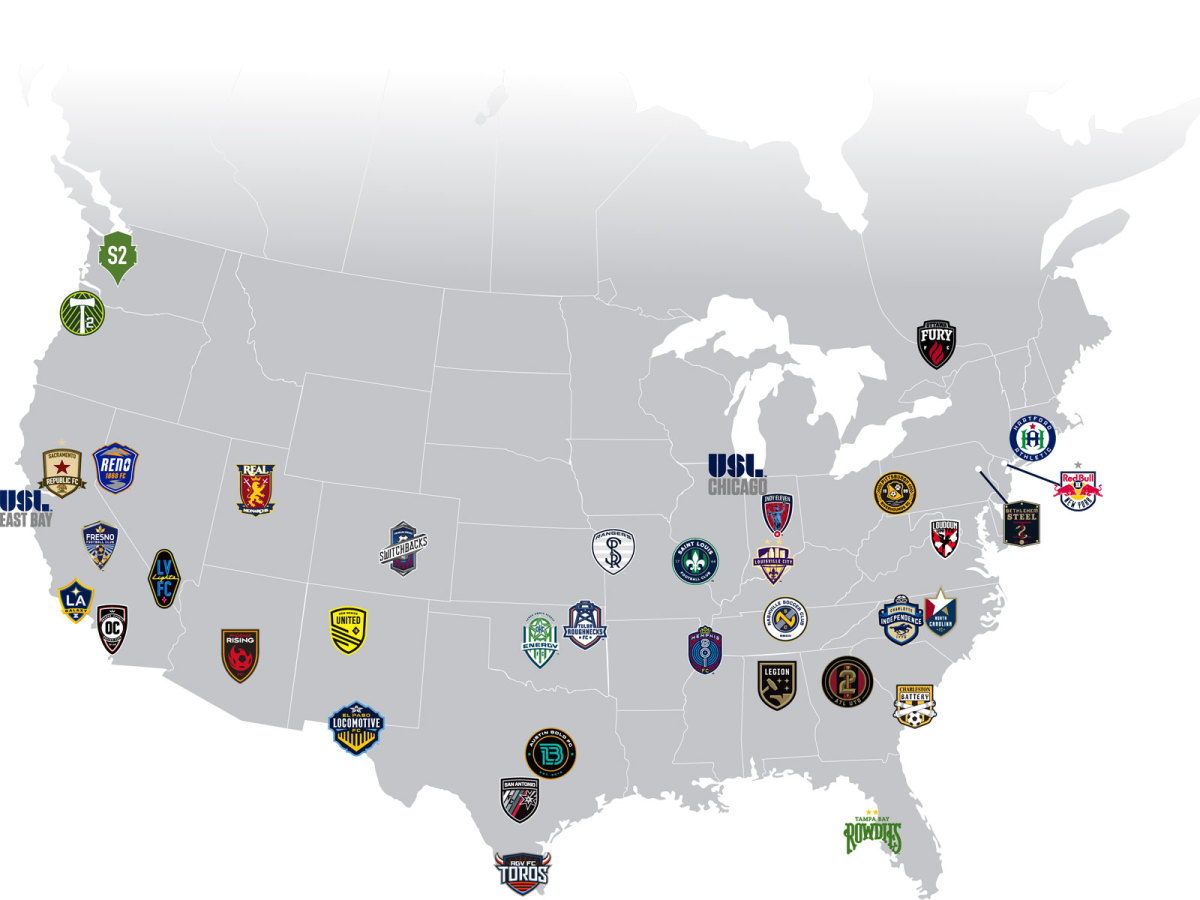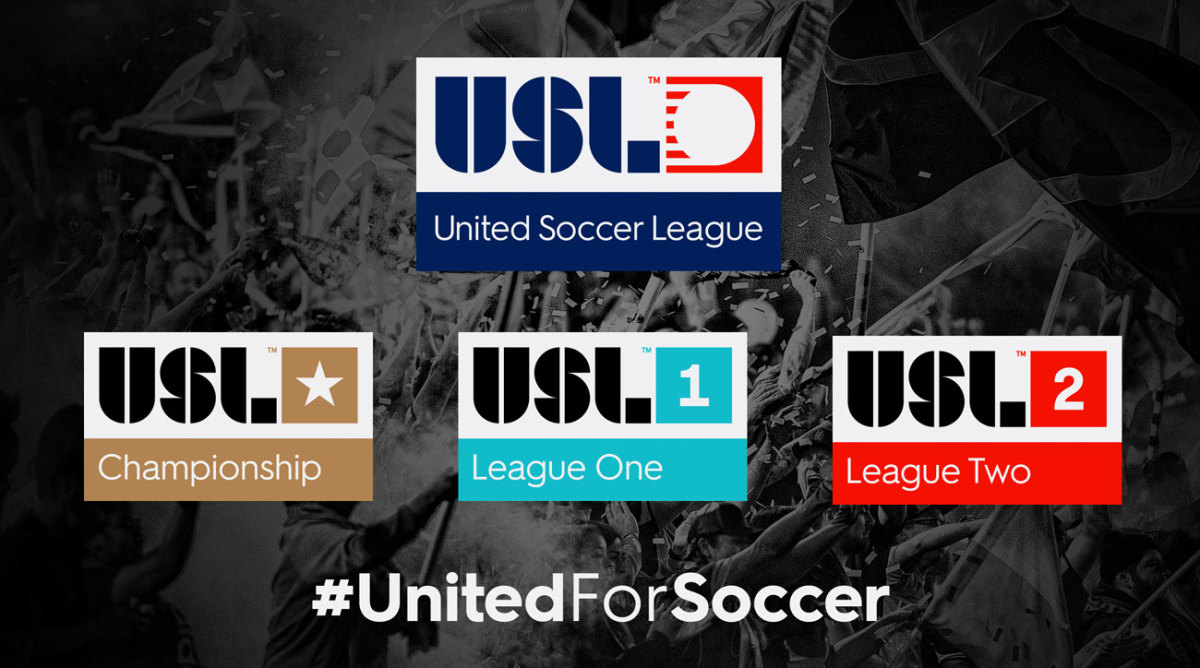As American Soccer Builds Toward 2026, USL Ramps Up Its Ambition

World Cup 2026 in North America is still seven years away, but when USL president Jake Edwards envisions the American soccer landscape in ’26, he sees one that is fundamentally changed from the one of today—due in no small part to the growth of the USL, both in its rechristened second-tier “Championship” and in the debut of its third-tier “League One” in 2019.
What does that 2026 landscape include below the first tier of MLS? A 40-team Championship. A 40-team League One. Soccer stadiums and youth academies for all the independent teams (those separate from the MLS second teams involved in USL). An Inter-League Cup knockout competition involving the Championship and League One as soon as 2020. And, when including MLS, more than 100 pro soccer clubs across the United States.
Oh, and it might include promotion and relegation—at least between the second and third divisions. (More on that later.)
“Right now, the Championship has 36 professional teams competing, and we’re launching League One with 10 professional clubs,” said Edwards in an interview about USL’s long-term strategy. “So it’s 46 professional teams across the country in our set-up right now. We’re looking at the ideal number [in the Championship] somewhere around 38 or 40, and that’s where we’re going to top out and cease expansion. What that means is there will be a number of teams—probably 10 or 12—currently in our Championship that will come out of our league over the next years and go into League One.
“That leaves us with about 15 expansion spots for the Championship between now and 2026,” Edwards continued. “We’re happy to say that supply is limited, and the demand is extremely high … I think forward, and in five years time we’re going to look at a professional soccer landscape very similar to other countries around the world that have great stadiums, not just in the top division but in the couple divisions below.”

U.S. Soccer has set standards for the three divisions in the areas of ownership, stadium and market size. The first tier (MLS) needs an owner with a net worth greater than $40 million ($70 million if it’s a group), a stadium of greater than 15,000 capacity and a market size of at least one million people. The second tier (USL Championship) needs a local owner with a net worth greater than $20 million, a stadium capacity greater than 5,000 and a market size of at least 750,000 people. And the third tier (USL League One) needs a local owner with a net worth greater than $10 million, a stadium capacity greater than 3,500 and a market size of at least 150,000.
USL will have 14 new expansion teams in 2019 alone. In the Championship, those are Memphis 901, Austin Bold, Birmingham Legion, New Mexico United, El Paso Locomotive, Hartford Athletic and Loudon (Va.) United. In League One, those are Chattanooga Red Wolves, FC Tucson, Forward Madison, Greenville Triumph, Lansing Ignite, North Texas and South Georgia Tormenta.
Edwards said USL plans to announce three more Championship expansion teams by this summer (one on West Coast and two on the East Coast), and he added that USL is in advanced discussions with two high-profile European clubs about owning teams in League One.
“The ownership dynamic has really changed,” he said. “It’s really well-capitalized individuals who are excited about the growth trajectory of this sport. Right now, purchasing a USL team is a $7 million franchise fee. Five years ago it was $300,000.”
CREDITOR: Crew Change Course From Relocation to Unlikely Rejuvenation
As for promotion and relegation, Edwards wouldn’t rule it out, though he only discussed potential pro/rel between the second and third divisions, not with MLS (which has had a close working relationship with USL in recent years).
“I think there’s a realistic possibility [of promotion and relegation],” Edwards said. “The sport is evolving, the sport is changing. What is considered normal now might not be correct in a couple of seasons’ time. How we’re approaching that, and I get asked the question all the time, is the launch of our second league, League One. A lot of focus and attention needs to go into building that league up over a short period of time. But we’ve got to get the right owners in League One, the right stadiums and infrastructure. We’ve got to make sure the quality on the field is at a good standard. You have to create parity as much as you can between the two divisions. Of course, the Championship will be different from League One in many respects, but it can’t be obscenely different.”
Edwards said that all the USL Championship games will be broadcast on ESPN+ again this season. Meanwhile, sources with knowledge of the situation said that a deal is close that would put all USL League One games on ESPN+ this season as well.

One team that will not be joining USL this season is the New York Cosmos, late of the NASL, which is still in litigation with U.S. Soccer over the demise of that league. When asked about the Cosmos, Edwards noted the ongoing litigation, but he did say that he had met with Cosmos owner Rocco Commisso two years ago about the possibility of joining USL. Commisso decided to go in a different direction at the time, Edwards said.
An Inter-League Cup for 2020 involving all the teams in the second and third tiers is moving forward, Edwards said.
“We haven’t had that before in the U.S.,” he said. “You see it overseas, and I think there’s merit behind it. We’ve presented it to our board, and they got an initial reaction that was positive. We’ll go back to our board later this spring to give them a final presentation … It will have a naming-rights partner behind it, and a media platform and prize money.”
Edwards had a few things to say on other topics involving USL, including:
• The new players union. “I will be moving forward now with a new partner, and we’re working with them now to identify the right process to begin a CBA negotiation,” Edwards said. “We’ll embark on that this year.”
• The potential Chicago stadium situation. Even though plans for a 20,000-seat soccer stadium on the north side of Chicago hit a snag recently when it failed to receive the backing of local politicians, Edwards said plans for a USL team are still ongoing. “The folks at Sterling Bay are committed to the project, as are we,” he said.
• As the U.S. soccer community awaits a FIFA ruling on whether training compensation and solidarity payments will start to be required in the United States, Edwards joined MLS commissioner Don Garber in saying the USL would welcome their institution. “Absolutely, we would like to see such a structure in place over here,” he said. “I think it would do a tremendous amount of good to get in line, and by doing so help incentivize the movement of players. We’re thinking about building youth academies and infrastructure for training complexes and investing in quality coaches to train kids at younger ages, and we want to create a development pathway to become a professional player.”
• The Ottawa Fury. After its league membership status was up in the air—it looked toward the end of 2019 that Ottawa might have to play in the new Canadian Premier League in 2019—the Fury was allowed to play in USL this season. “We support any decision they make in the future to join the Canadian league, and we’ve adjusted our agreement with them to give them the ability to do that,” Edwards said. “What that means for 2020 and beyond, I don’t have an answer just yet.”
Clearly, there’s a lot on Edwards’s plate these days, and that doesn’t figure to change between now and World Cup ’26 if he can help it. To call his plans for USL ambitious might be an understatement.
“Look what’s being built here, but look ahead the next five years when that massive roadshow of the World Cup comes to town and the whole world is looking at this country,” he said. “We’re going to put our best foot forward and look at the infrastructure, and everything that will happen in the first, second and third divisions is going to be very compelling. It’s a lot of work ahead of us, but we’re up for it.”
